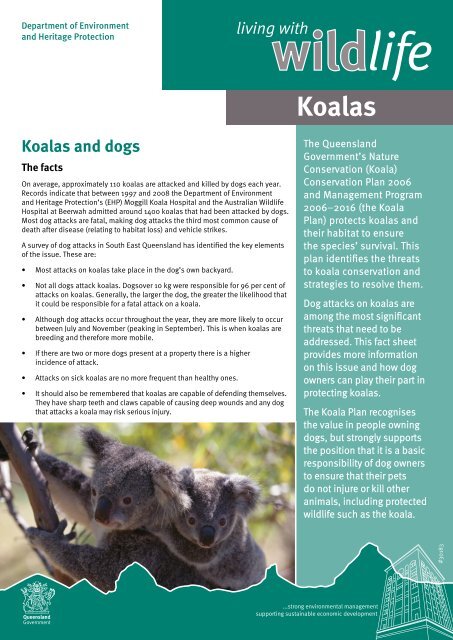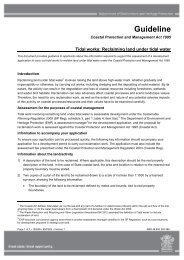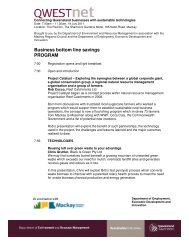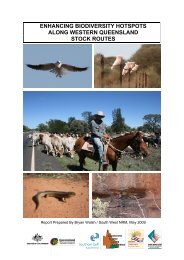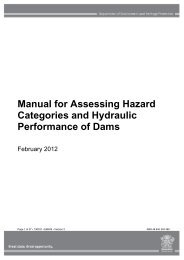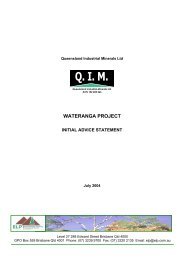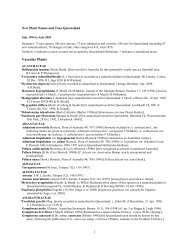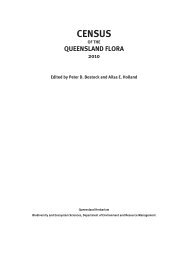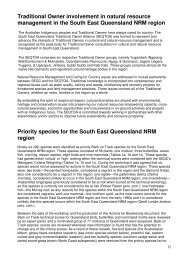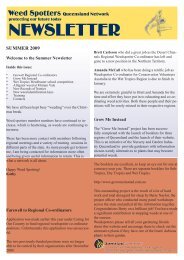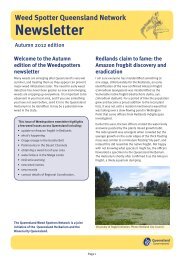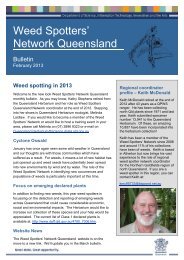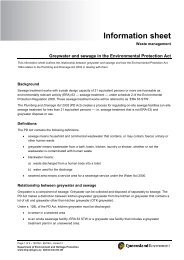Living with wildlife - koalas and dogs - Department of Environment ...
Living with wildlife - koalas and dogs - Department of Environment ...
Living with wildlife - koalas and dogs - Department of Environment ...
Create successful ePaper yourself
Turn your PDF publications into a flip-book with our unique Google optimized e-Paper software.
<strong>Department</strong> <strong>of</strong> <strong>Environment</strong><br />
<strong>and</strong> Heritage Protection<br />
Koalas <strong>and</strong> <strong>dogs</strong><br />
The facts<br />
On average, approximately 110 <strong>koalas</strong> are attacked <strong>and</strong> killed by <strong>dogs</strong> each year.<br />
Records indicate that between 1997 <strong>and</strong> 2008 the <strong>Department</strong> <strong>of</strong> <strong>Environment</strong><br />
<strong>and</strong> Heritage Protection’s (EHP) Moggill Koala Hospital <strong>and</strong> the Australian Wildlife<br />
Hospital at Beerwah admitted around 1400 <strong>koalas</strong> that had been attacked by <strong>dogs</strong>.<br />
Most dog attacks are fatal, making dog attacks the third most common cause <strong>of</strong><br />
death after disease (relating to habitat loss) <strong>and</strong> vehicle strikes.<br />
A survey <strong>of</strong> dog attacks in South East Queensl<strong>and</strong> has identified the key elements<br />
<strong>of</strong> the issue. These are:<br />
• Most attacks on <strong>koalas</strong> take place in the dog’s own backyard.<br />
• Not all <strong>dogs</strong> attack <strong>koalas</strong>. Dogsover 10 kg were responsible for 96 per cent <strong>of</strong><br />
attacks on <strong>koalas</strong>. Generally, the larger the dog, the greater the likelihood that<br />
it could be responsible for a fatal attack on a koala.<br />
• Although dog attacks occur throughout the year, they are more likely to occur<br />
between July <strong>and</strong> November (peaking in September). This is when <strong>koalas</strong> are<br />
breeding <strong>and</strong> therefore more mobile.<br />
• If there are two or more <strong>dogs</strong> present at a property there is a higher<br />
incidence <strong>of</strong> attack.<br />
• Attacks on sick <strong>koalas</strong> are no more frequent than healthy ones.<br />
• It should also be remembered that <strong>koalas</strong> are capable <strong>of</strong> defending themselves.<br />
They have sharp teeth <strong>and</strong> claws capable <strong>of</strong> causing deep wounds <strong>and</strong> any dog<br />
that attacks a koala may risk serious injury.<br />
Koalas<br />
The Queensl<strong>and</strong><br />
Government’s Nature<br />
Conservation (Koala)<br />
Conservation Plan 2006<br />
<strong>and</strong> Management Program<br />
2006–2016 (the Koala<br />
Plan) protects <strong>koalas</strong> <strong>and</strong><br />
their habitat to ensure<br />
the species’ survival. This<br />
plan identifies the threats<br />
to koala conservation <strong>and</strong><br />
strategies to resolve them.<br />
Dog attacks on <strong>koalas</strong> are<br />
among the most significant<br />
threats that need to be<br />
addressed. This fact sheet<br />
provides more information<br />
on this issue <strong>and</strong> how dog<br />
owners can play their part in<br />
protecting <strong>koalas</strong>.<br />
The Koala Plan recognises<br />
the value in people owning<br />
<strong>dogs</strong>, but strongly supports<br />
the position that it is a basic<br />
responsibility <strong>of</strong> dog owners<br />
to ensure that their pets<br />
do not injure or kill other<br />
animals, including protected<br />
<strong>wildlife</strong> such as the koala.<br />
...strong environmental management<br />
supporting sustainable economic development<br />
#30183
<strong>Department</strong> <strong>of</strong> <strong>Environment</strong><br />
<strong>and</strong> Heritage Protection<br />
Take extra care <strong>with</strong> your dog<br />
when <strong>koalas</strong> are breeding<br />
Between July <strong>and</strong> November, adult<br />
<strong>koalas</strong> will be moving around in search<br />
<strong>of</strong> mates, <strong>with</strong> males trying to establish<br />
their dominance over an area. At this<br />
time independent young, born the<br />
previous year, will also be leaving their<br />
mothers’ home range in search <strong>of</strong> new<br />
areas. This is the time <strong>of</strong> year when<br />
<strong>koalas</strong> are at their most vulnerable to<br />
dog attack <strong>and</strong> dog owners should do<br />
whatever they can to keep <strong>koalas</strong> safe.<br />
What can I do to make<br />
my dog, <strong>and</strong> property,<br />
koala-friendly?<br />
The following range <strong>of</strong> measures can<br />
be considered by dog owners to reduce<br />
the risk <strong>of</strong> their dog attacking a koala.<br />
Keep your dog under control<br />
at night<br />
Most koala attacks occur at night so<br />
limit your dog’s movements at this<br />
time to greatly reduce any likelihood<br />
<strong>of</strong> it chasing or catching a koala.<br />
The solution can be as simple as<br />
keeping your dog inside or on an<br />
enclosed deck or ver<strong>and</strong>a at night—<br />
where it can be both a better watchdog<br />
<strong>and</strong> a better companion. Kennels <strong>and</strong><br />
other forms <strong>of</strong> enclosures can also be<br />
used to confine <strong>dogs</strong>, or they can be<br />
kept comfortably on leads—especially<br />
if they are given something like a bone<br />
to stop them from getting bored.<br />
Don’t assume your dog is<br />
koala friendly<br />
Dogs sometimes behave differently<br />
when their owner is not present,<br />
particularly if a strange person or<br />
animal enters what they consider to be<br />
their territory. Making sure <strong>koalas</strong> are<br />
safe to traverse your backyard could<br />
save you from discovering an injured or<br />
dead koala when you return home.<br />
Keep your dog <strong>and</strong> <strong>koalas</strong> apart<br />
If a dog is worrying a koala that is in a<br />
tree, remove the dog from the area so<br />
that the koala can come down from the<br />
tree <strong>and</strong> move out <strong>of</strong> the area <strong>with</strong>out<br />
any further disturbance. Be mindful<br />
that your yard may be a part <strong>of</strong> this<br />
koala’s home range <strong>and</strong> it could return<br />
in the future.<br />
Where confining a dog is not possible,<br />
another option is to keep the <strong>koalas</strong><br />
out <strong>of</strong> a yard through the use <strong>of</strong> koala<br />
exclusion fencing.<br />
Existing fences can be modified to<br />
exclude <strong>koalas</strong> by attaching a smooth<br />
metal or perspex strip at least 50 cm<br />
in height to the top <strong>of</strong> the fence that<br />
<strong>koalas</strong> are unable to grip. Fences<br />
can also be made <strong>with</strong> a section <strong>of</strong><br />
unsupported wire (usually chain link<br />
wire mesh) at the top so that when a<br />
koala climbs on it, the top <strong>of</strong> the fence<br />
flops over under the animal’s weight,<br />
forcing it to jump back to the ground.<br />
Where a new fence is being installed,<br />
it can be made from materials that<br />
a koala can’t climb e.g. sheet metal<br />
or fibre sheeting products. Trees <strong>and</strong><br />
shrubs should be at least 3 m away<br />
from exclusion fencing.<br />
In some cases, the cost <strong>of</strong> altering or<br />
building fences will not be practical <strong>and</strong><br />
may make the option <strong>of</strong> constructing<br />
a smaller enclosure for a dog or even<br />
using a lead worth reconsidering.<br />
Koalas<br />
Check the trees on your property<br />
to see if <strong>koalas</strong> are present<br />
Before leaving your dog unsupervised<br />
in your yard, check to see if there are<br />
any <strong>koalas</strong> in trees on your property.<br />
Ask your neighbours if they have seen<br />
<strong>koalas</strong> in the area recently.<br />
Train your dog to stop chasing<br />
other animals<br />
If you are concerned that your dog<br />
might chase a koala, another option<br />
is to consider obedience training.<br />
This will not only protect <strong>koalas</strong> but<br />
also give you greater control over your<br />
dog. Advice on obedience training<br />
techniques can be provided by dog<br />
training schools in your area.<br />
Check <strong>with</strong> your local government to<br />
see what dog owners are required to do<br />
to protect <strong>koalas</strong> from dog attack.<br />
Choose a small dog<br />
If you are getting a new dog <strong>and</strong> it<br />
will be living in an area inhabited by<br />
<strong>koalas</strong>, consider getting one that is<br />
unlikely to grow to a size greater than<br />
7 kg. Small dog breeds can provide<br />
the same companionship <strong>and</strong> property<br />
protection as larger <strong>dogs</strong>, but pose<br />
a lesser threat to <strong>koalas</strong>. There are a<br />
range <strong>of</strong> breeds <strong>and</strong> crosses that fall<br />
<strong>with</strong>in this size range, including many<br />
<strong>of</strong> the terriers.
<strong>Department</strong> <strong>of</strong> <strong>Environment</strong><br />
<strong>and</strong> Heritage Protection<br />
What should I do if my dog<br />
has attacked a koala?<br />
The first thing to do is to remove the<br />
dog from the site <strong>of</strong> the attack. Even<br />
the briefest contact between the<br />
dog <strong>and</strong> koala can cause significant<br />
injuries, so you should contact<br />
your local <strong>wildlife</strong> care <strong>and</strong> rescue<br />
organisation by ringing the RSPCA on<br />
1300 ANIMAL (1300 264 625). If the<br />
koala is dead, its pouch should be<br />
checked for young, which can be<br />
cared for <strong>and</strong> ultimately released back<br />
into the wild. Dead <strong>koalas</strong> need to be<br />
reported to EHP or your local <strong>wildlife</strong><br />
care organisation.<br />
If the koala is alive, it is very important<br />
that you do not put yourself in a<br />
position to be injured or expose the<br />
koala to further injury <strong>and</strong> stress.<br />
Avoid interfering <strong>with</strong> the koala if<br />
possible until a <strong>wildlife</strong> carer can collect<br />
the animal. You can confine an injured<br />
koala temporarily while waiting for a<br />
<strong>wildlife</strong> carer by placing an upturned<br />
box, washing basket or large bin over<br />
the top <strong>of</strong> it <strong>with</strong> a weight on top.<br />
However, if you are forced to catch the<br />
koala in order to transport it to a <strong>wildlife</strong><br />
carer or a vet, there are a number <strong>of</strong><br />
precautions you can take. Wear thick,<br />
long gloves that protect your forearms<br />
if they are available, <strong>and</strong> use a towel or<br />
blanket to immobilise the koala before<br />
picking it up. The koala should be placed<br />
in a cardboard box that can be closed<br />
<strong>and</strong> <strong>with</strong> a hessian bag or towel on the<br />
bottom for it to grip on to. Any h<strong>and</strong>ling<br />
should be carried out quickly to avoid<br />
making the koala struggle <strong>and</strong> causing it<br />
unnecessary stress.<br />
Do <strong>koalas</strong> live near you?<br />
You may not even realise that <strong>koalas</strong> live<br />
nearby <strong>and</strong> cross your property. If you<br />
are not sure if <strong>koalas</strong> are in your area<br />
visit the EHP website www.ehp.qld.gov.<br />
au/<strong>wildlife</strong>/<strong>koalas</strong>/mapping/index.html<br />
to find out if your property falls <strong>with</strong>in<br />
a known koala habitat area. You can<br />
also check the trees on your property<br />
for signs <strong>of</strong> <strong>koalas</strong>. While <strong>koalas</strong> can be<br />
hard to see, they leave behind obvious<br />
scratches on the trunks <strong>of</strong> trees <strong>and</strong><br />
scattered pellet-shaped droppings on<br />
the ground. In the breeding season you<br />
may hear male <strong>koalas</strong> calling. You can<br />
also ask your neighbours if they have<br />
seen <strong>koalas</strong> in the area.<br />
Koalas<br />
Further information<br />
Visit www.ehp.qld.gov.au<br />
How can we be more<br />
koala-friendly in new<br />
urban developments?<br />
Where new urban areas are being<br />
planned <strong>and</strong> developed, a number<br />
<strong>of</strong> koala-friendly measures may be<br />
considered which will ensure <strong>koalas</strong><br />
can move safely <strong>and</strong> freely across the<br />
l<strong>and</strong>scape. These measures include:<br />
• incorporating koala sensitive<br />
development into the planning,<br />
design <strong>and</strong> construction <strong>of</strong><br />
the development<br />
• restrictions on dog ownership<br />
using covenants or community title<br />
restrictions may involve creating<br />
‘dog-free’ or ‘small-dog’ estates<br />
• constructing koala exclusion<br />
fencing on part <strong>of</strong> a lot or premises<br />
to separate <strong>dogs</strong> from <strong>koalas</strong>.<br />
For general enquiries related to <strong>wildlife</strong><br />
call 13 QGOV (13 74 68)<br />
To report sick, injured or orphaned <strong>wildlife</strong><br />
call RSPCA Queensl<strong>and</strong> on 1300 ANIMAL (1300 264 625)<br />
For licensed <strong>wildlife</strong> relocators in your area or advice<br />
about <strong>wildlife</strong> around your home or business<br />
please call the department on 1300 130 372


